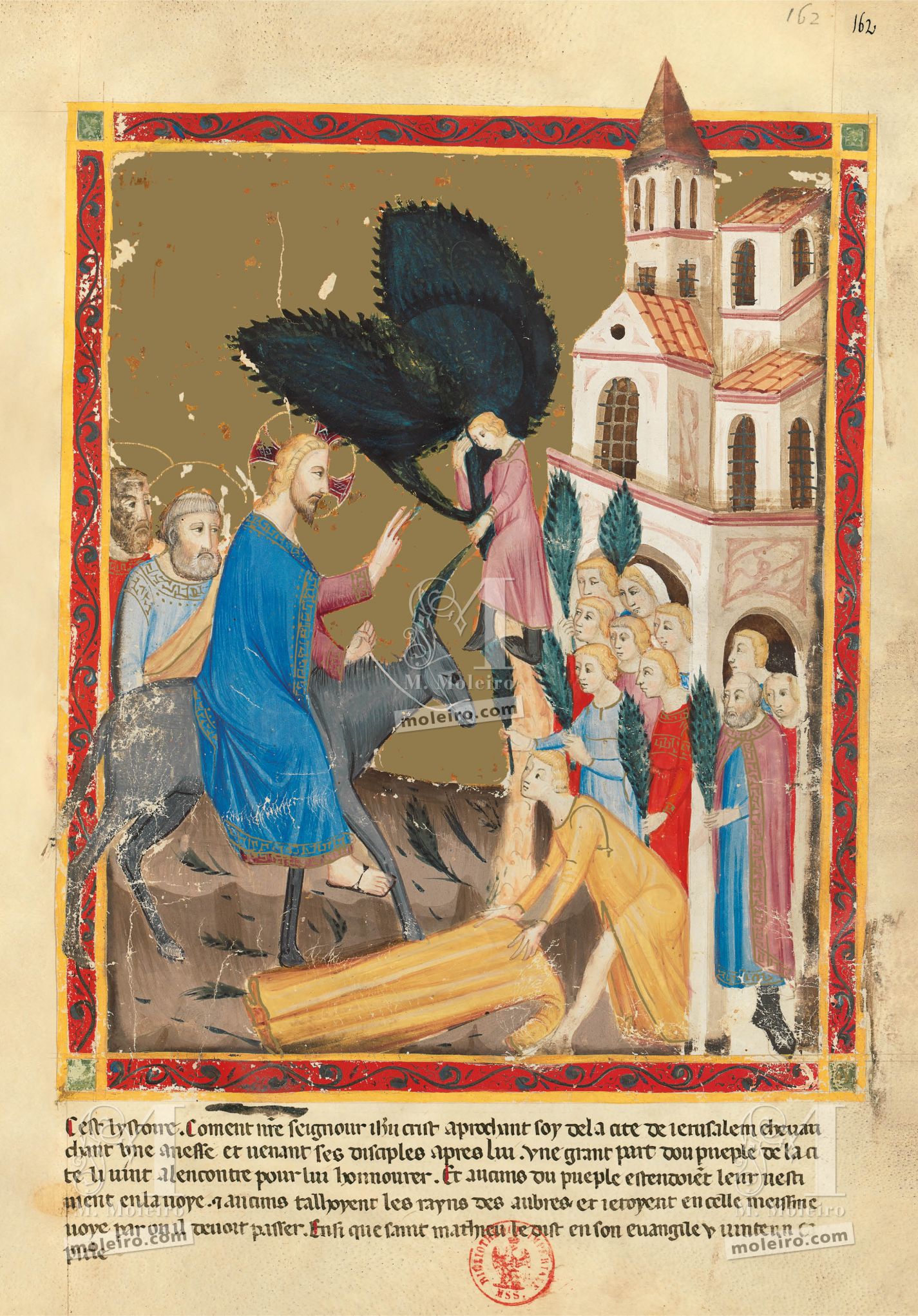“This is the story: How Our Lord Jesus Christ was riding to the city of Jerusalem on an ass with his disciples following him and many of the city’s people came to meet and honour him. And one of the people lay his gown on the road and one climbed into the branches of trees and cast them on the very road where he was to pass. Thus says Saint Matthew in his Gospel in the twenty-first chapter.”
The episode of Christ’s entry into Jerusalem gave rise to several masterpieces in the pictorial art of the Italian Trecento in the first third of the century (Giotto’s frieze in Padua, Duccio’s predella panel in Sienna, Pietro Lorenzetti’s fresco in Assisi). The Neapolitan miniaturist drew upon the canonical model of the great Tuscan masters for the illustration of Matthew’s text glossed beneath the illumination, although all four evangelists related the event.
Christ rides towards the holy city on an ass to convey his humility. His disciples follow him and as usual, artist A depicts Peter, the first apostle, walking along closest to Christ by the animal’s hindquarters. There is no landscape but a gold ground illuminates the scene featuring a large, dark green tree with roughly drawn, thick foliage. A man clutches the trunk and cuts branches which he throws to the ground as mentioned in the paraphrase whilst another spreads his cloak on the road as carpet of honour. The crowd gathered at the city gates waves palm leaves to greet the prophet Jesus, the Son of David. The white buildings crammed together loom up above the wall to form a colourless ghost town with windows covered in iron grilles. This conventional, static painting merely translates the accompanying text exactly: commemorating rather than narrating.
Yves Christe
University of Geneva
Marianne Besseyre
Illuminated Manuscripts Research Center, Bibliothèque nationale de France
Fragment of the Bible moralisée of Naples commentary volume

“This is the story: How Our Lord Jesus Christ was riding to the city of Jerusalem on an ass with his disciples following him and many of the city’s people came to meet and honour him. And one of the people lay his gown on the road and one climbed into the branches of trees and cast them on the very road where he was to pass. Thus says Saint Matthew in his Gospel in the twenty-first chapter.”
The episode of Christ’s entry into Jerusalem gave rise to several masterpieces in the pictorial art of the Italian Trecento in the first third of the century (Giotto’s frieze in Padua, Duccio’s predella panel in Sienna, Pietro Lorenzetti’s fresco in Assisi). The Neapolitan miniaturist drew upon the canonical model of the great Tuscan masters for the illustration of Matthew’s text glossed beneath the illumination, although all four evangelists related the event.
Christ rides towards the holy city on an ass to convey his humility. His disciples follow him and as usual, artist A depicts Peter, the first apostle, walking along closest to Christ by the animal’s hindquarters. There is no landscape but a gold ground illuminates the scene featuring a large, dark green tree with roughly drawn, thick foliage. A man clutches the trunk and cuts branches which he throws to the ground as mentioned in the paraphrase whilst another spreads his cloak on the road as carpet of honour. The crowd gathered at the city gates waves palm leaves to greet the prophet Jesus, the Son of David. The white buildings crammed together loom up above the wall to form a colourless ghost town with windows covered in iron grilles. This conventional, static painting merely translates the accompanying text exactly: commemorating rather than narrating.
Yves Christe
University of Geneva
Marianne Besseyre
Illuminated Manuscripts Research Center, Bibliothèque nationale de France
Fragment of the Bible moralisée of Naples commentary volume